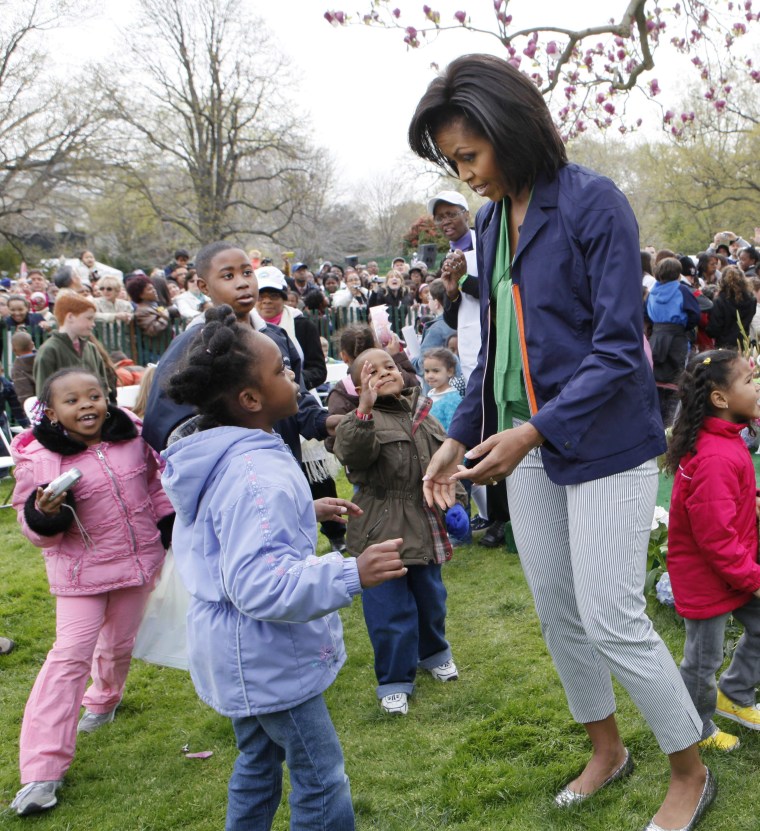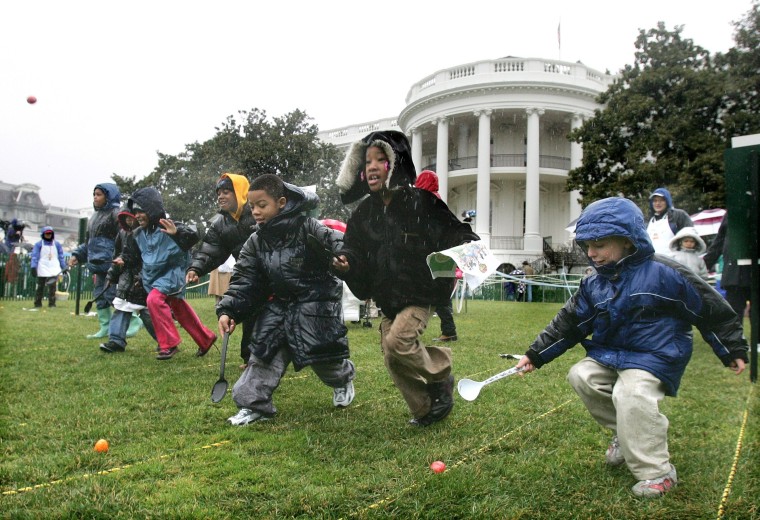If it's Easter Monday in Washington, it's time for the White House Easter Egg Roll.
The White House is getting ready, putting on the finishing touches before the gates open and 30,000 men, women and children scramble to take part in the annual tradition. The Easter Bunny and more than 14,500 hard-boiled eggs are dyed and waiting.
Public access to the South Lawn is as rare as sightings of the Easter Bunny. The White House grounds are open to the average public just two weekends a year, for the spring and fall garden tours. The Easter Egg Roll is the only event where people get to walk across the meticulously tended South Lawn.
The event dates to 1878 and has a rich history.
Two world wars and weather have caused the "eggcitement" to be canceled several times. The fun and games are at the president's home, but he isn't always there to join the fun. The event is usually a signal that spring has arrived in the nation's capital.
It's long-standing policy: No child or adult can attend alone. But decades ago in the 1930s, as the event grew more popular, kids and grown-ups alike figured out some "eggceptional" ways around the rule.
Children would mingle with tourists and others passing by the White House gates, and hoped they could talk someone into escorting them through security and into the festivities on the South Lawn.
Eager to stroll the plush grounds, adults would dig into their purses and pockets to pay a nickel, a quarter or whatever the going rate was at the time to "adopt" a child long enough to get inside, too.
Once past the guards, they often parted company. Sometimes, the kids headed back out through a different gate in search of another parent for hire — and more money for their pockets.
The scam continued to such a degree that one newspaper headline in 1935 screamed: "Children Outside Gates Turn Racketeer and Take Sunday Elders for a Nickel Fee," according to the National Archives. One 11-year-old boy said the five quarters he earned one Easter Monday helped pay the weekly rent for the rooms he lived in with his mother and three siblings.
Secret Service agents were posted at the gates in 1939 to break up the racket.

Nowadays, it takes more than just sweet talk to get into the "eggstravaganza." It takes a ticket.
It used to be that on the weekend before the Easter Egg Roll, anyone who wanted tickets had to wait in line outside a booth near the White House, regardless of the weather. And getting a ticket was not guaranteed.
But that changed under President Barack Obama and his wife, first lady Michelle Obama.
For the first time last year — the Obamas' first in the White House — tickets were distributed through an online lottery.
The White House said it made the change to give more families from across the country a chance to participate in what is the longest annual presidential tradition on the South Lawn. It also mean people now can apply for tickets from the comfort of their homes.
The Egg Roll through the yearsIt's the White House Easter Egg Roll, but the fun and games didn't originate at 1600 Pennsylvania Ave.
The west front of the Capitol has a steep, grassy slope that made it an ideal venue for egg rolling, and children had been taking their colored eggs and rolling them down the hill there for years on Easter Monday.
But after putting up with noisy children and watching them trample the grass, members of Congress decided they'd had enough. A bill passed and signed by President Ulysses S. Grant in 1876 banned such activity to prevent "injury" to the Capitol grounds and grass.
In 1877, it rained so hard that the egg roll was canceled, so the Capitol Police didn't have to enforce the new law.
The officers would have no such luck the following year, however, when chasing away basket-toting egg rollers as they arrived at the Capitol.

"Eggsasperated" egg rollers then headed west on Pennsylvania Avenue in search of an alternate site after word spread for them to go to the White House, according to the White House Historical Association.
As the story goes, President Rutherford B. Hayes was out for his daily walk a few days before Easter in 1878 when a boy approached and asked Hayes if he'd let them roll eggs at the White House. The still-new president was not familiar with the tradition, partly because the event was rained out his first year in office, in 1877.
Hayes told the boy he'd check with his staff. Back at the White House, the president inquired about egg rolling. He instructed the staff to let the kids through the gates if they showed up on Easter Monday, and not to make a fuss.
When Monday arrived, the egg rollers did, too.
The next year, on the eve of Easter in 1879, another boy approached Hayes as he was walking to ask about egg rolling at the White House. Hayes replied that he thought there would be no objection to it.
By 1880, however, no child bothered to check beforehand with Hayes. Egg rollers showed up and took over the south grounds of the White House. The tradition of a White House Easter Egg Roll was well under way.
Here are a few more tales from White House Easter Egg Roll history.
- Cue the music: Eleven years after the Easter Egg Roll became a White House tradition, President Benjamin Harrison added music in 1889. The United States Marine Band, also known as "The President's Own," played as children romped on the South Lawn. Band director John Philip Sousa, composer of "The Star Spangled Banner," enjoyed treating them to rousing marches as they scampered about. He honored the occasion of the Easter Egg Roll with his composition, "Easter Monday on the White House Lawn," in 1929.
- Let the games begin: If it's Easter Monday, eggs are being rolled across the White House South Lawn. But other egg games were played during the affairs early years, such as egg ball, toss and catch, egg croquet and egg picking — in which eggs were pecked together until they cracked. After a few days, the odor from all the broken eggs filled the air with a stench for at least a few miles.
- The first egg races: President Richard Nixon and first lady Patricia Nixon hosted the first egg roll races in 1974. They have become an Easter Monday favorite.
- No egg roll: World War I and food rationing put the event on hold, scrambling it from 1917-1920. Egg rollers returned to the Capitol in 1942, from which they had been banished 64 years earlier, in 1878. World War II stopped the festivities again from 1943-1945.
- Event hiatus: President Harry Truman did not host an Easter egg roll during his two terms in office. Food conservation efforts led him to cancel the affair from 1946-1947. After that, White House renovations turned the South Lawn into a construction zone from 1948-1952. President Dwight D. Eisenhower revived the tradition in 1953, after a 12-year hiatus.
- Where's the president? Several of Eisenhower's successors could not be at the White House on Easter Monday to greet the visiting egg rollers. President Gerald Ford resumed the tradition of presidential appearances at the Easter Egg Roll in 1976 — making him the first chief executive to do so since Eisenhower played host in 1960. President Bill Clinton and his wife, Hillary Rodham Clinton, attended every egg roll of their eight years in the White House. President Barack Obama presided over last year's egg roll, his first.
- Trinkets: Patricia Nixon distributed certificates of participation as a souvenir to all egg rollers. First ladies Betty Ford and Rosalynn Carter distributed plastic eggs with printed notes inside from the first lady. In 1981, President Ronald Reagan and first lady Nancy Reagan arranged a hunt for wooden eggs printed with the signatures of famous people. Wooden eggs soon became the official White House Easter Egg Roll keepsake.
- White House bunny: In 1969, a member of Patricia Nixon's staff put on a white fleece costume with ears, and so was born the tradition of an official White House Easter Bunny. When the event was canceled in 1984 because of rain, Reagan's staff — led by the wife of Attorney General Edwin Meese, wearing a disguise — organized a tour through the White House as consolation. Goody bags also were distributed. Occasional "celebrity" bunnies would appear, including NBC weatherman Willard Scott.